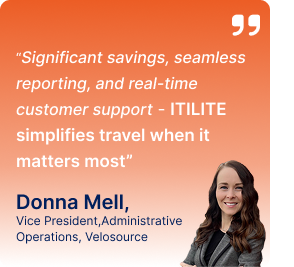
After almost reaching a standstill during Covid-19, business travel is gradually returning to normalcy. An extensive research report by Morgan Stanley states that 34% of global companies anticipate a complete recovery of their travel levels in 2023.
As more and more companies are gearing up to green-light business travel, they are turning towards travel management companies (TMCs) to optimize their travel process.
If your organization is also looking for the right corporate travel management company, you must consider various factors before investing. The TMC pricing structure is one of them. Evaluating pricing models before investing in a travel management company is essential to ensure you don’t overspend on travel management.
In the current market, numerous travel management company cost structures are available. The variety ranges from a subscription-based model requiring regular commitment to a per-trip fee model, where you only pay when you travel.
Due to this diversity, it is hard to decide which TMC is suitable for your company using an apples-to-apples comparison of how much it charges for each booking. You must evaluate each TMC pricing structure’s pros and cons individually to pick the right option.
We are here to help you with that. Let’s learn more about the various TMC pricing structures and how to choose among them.
Most Prevalent TMC Pricing Models
Here are the most commonly prevalent TMC pricing models:
1. Per-service Charge Model
In the Per-service charge model, the TMC levies a fixed fee for all online bookings and separate charges for all offline transactions. Hence, aside from a basic booking fee, you have to pay extra every time you need on-call assistance.
For instance, the booking fee you might have to pay could be $7 if you use TMC’s online platform. However, if your travelers need to reschedule their flight or change their hotel, you might have to pay an extra $20 each time they call the TMC’s support team. So, even though the TMC is charging just $7 for booking, the additional support charges can drive up your travel costs in the blink of an eye.
A TMC deploying the Per-service charge model is suitable for your company if you have a low travel volume. This is because less number of trips can be managed online easily, and the basic online booking fee is generally nominal. Moreover, even if a few unanticipated offline requests come up, they won’t carve a massive hole in your pocket.
Alternatively, if your company’s travel volume is large, this model is unsuitable because the frequency of offline booking and additional support requirements increases. Hence, it will drive up the total trip cost.
Pros
- Flexibility: With the Per-service charge model, you only have to pay when you book. There is no regular payment.
- Tailored services: A TMC can offer more tailored services based on your specific needs and usage.
Cons
- Death by a thousand cuts: A TMC using this model can drive up your travel costs by levying extra charges for all offline services, resulting in “death by a thousand cuts.”
- Lack of predictability: Predicting the total cost of a business trip becomes difficult because you can’t anticipate the additional support that will be required.
2. Hybrid Model
A hybrid pricing model combines an annual fee and an additional fee per transaction. This might seem similar to the Per-service charge model; however, there is a key difference. Unlike a basic booking fee in the Per-service charge model, the hybrid model requires you to pay a regular flat fee just to avail of the TMC’s services.
Most TMCs with a hybrid pricing model charge an annual fee depending on the size of the customer company. Some might also charge an additional onboarding fee.
Aside from that, the TMC gives you a rate card for each service, whether online or offline. So, you will be charged separately for flight and hotel booking, cancelation, and rescheduling. The TMC will also levy some fees for providing support and charge extra for non-office hours.
Pros
- Flexibility: With this model, you can get multiple additional services like visa management, rental car booking, and travel risk assessment.
- Budget predictability: The flat fee component of this pricing model provides budget predictability for certain services.
Cons
- High cost: The travel management costs will be higher because of the fixed and variable components.
- Lack of transparency: Because of the separate prices for each service, it can be hard to predict the total cost of a business trip.
- Cost leakage: The fixed fee component of this model is a cost leakage avenue because you have to pay even if your travel volume is zero.
3. Per-trip Fee Model
The Per-trip fee model is one of the newly emerging TMC pricing structures. A travel management company that charges according to this model will charge you only for the trips you book and quote the entire trip’s spending in a single, clean amount. There are no subscription or onboarding fees. You won’t have to pay any extra charges whether you book from TMC’s online travel software or with the help of an agent. Moreover, there are no additional hidden charges for rescheduling, cancellations, and travel support, during and after office hours.
Investing in a TMC with a Per-trip fee model can benefit companies with high or low travel volume. This is because the cost of each trip is calculated separately, and there is no fixed retainer fee or hidden charges. So, you only pay when you travel and only for the services you use.
Pros:
- Predictability: A single, clean per-trip price gives you greater predictability on the amount you will spend on each business trip.
- Cost-efficiency: The real payment amount adds up to be less than the Per-service Charge or Hybrid model because there are no hidden costs.
- No commitment required: You don’t have to pay any subscription fee to avail of TMC’s services.
- No unnecessary leakages: There are no additional charges for onboarding or support.
Cons:
- Higher booking charges: The prices may be excessive for companies that want only booking and do not require additional services or emergency support.
Some other TMC Pricing Models
4. Commission-based Model
In a commission-based TMC pricing model, the travel management company charges a pre-determined percentage of the total trip cost as its fees. The commission percentage can be different based on the client company’s size.
For example, if for a single trip, the total cost of the flight is $150, the hotel cost is $200, and the miscellaneous charges, including car rental and other concierge services, add up to $150, the total trip cost becomes $500. If the commission rate of the TMC is 10%, the fees will be $50.
A commission-based model benefits you if your road warrior employees don’t travel regularly. This is because the fee is charged only when the TMC makes travel arrangements. Hence, you don’t need to worry about a fixed amount being deducted from your pocket even when your travel volume is zero.
Pros
- Cost-Effectiveness: This pricing model can be highly cost-effective because the TMC charges you only when you travel. Moreover, the commission is calculated based on the trip total, so you don’t spend unnecessary money in the form of a flat fee.
- Greater Flexibility: The commission-based travel management company’s cost structure offers more flexibility in terms of services. With this model, you don’t need to adjust your travel requirements according to a subscription plan. If you need something extra, you can pay for it and get it without any hassle.
Cons
- Lack of Predictability: The commission-based model makes forecasting costs for travel budget preparation difficult for the finance team, as the commission paid will vary according to the trip cost.
- Conflict of Interest: With a commission-based model, the TMC may be more inclined to recommend more expensive travel options to increase their commission. Hence, there is a potential for a conflict of interest.
5. Negotiation-based Model
A negotiation-based TMC pricing structure is built on the interpersonal relationship of a travel management company with its client. In this model, the TMC and the client collectively determine various price ranges(lower than the market rate) according to the client’s travel-related requirements.
The TMC then negotiates the set prices with flight and hotel suppliers on behalf of the client.
This pricing model can be suitable for your organization if the employees partake in business travel regularly and in huge volume. The TMC can leverage your volume to negotiate with the suppliers and offer you more competitive prices.
Pros:
- Customized Pricing: You can negotiate specific price ranges for travel-related products and services you need. Moreover, you can also get better discounts if you have a high volume.
- Flexibility: You can adjust the travel budget and negotiate better deals depending on your travel needs.
Cons:
- Additional Charges: The TMCs may charge a fee for the negotiation process, which can increase the overall travel cost.
- Lack of Transparency: There is no way for you to know if the TMC has availed of the best flight and hotel deals as most negotiations happen interpersonally.
How to Choose the Most Suitable TMC Pricing Structure for Your Company?
Now that you know about various travel management company cost structures, and their advantages and disadvantages, you have come one step closer to finding the most suitable TMC that can help optimize your business travel management process.
With the information provided above, we can pinpoint that an ideal TMC pricing structure should have the following characteristics:
- Easier predictability: The rate card given by your TMC should not include a zillion travel-expense headers that are difficult to track. Instead, you should get a clean, single price for each trip, without any suspicious hidden charges. This way, you can easily predict the total travel spending in advance.
- No payment lock-ins: Payment lock-ins for business travel services are unnecessary and can poke a massive hole in your company’s pocket. You must steer clear of the TMC pricing models that require a monthly/quarterly/annual payment. This is because, in such cases, you will have to pay a certain amount even if your travel volume goes down to zero.
Besides keeping these characteristics in mind, you must evaluate each pricing structure to calculate the “real cost” you will pay for each booking.
The TMCs deploying the Per-service charge or Hybrid model may charge less for travel bookings. From a surface level, their pricing may seem highly lucrative; however, on deeper inspection, you will discover numerous hidden charges for additional services. These charges add up to increase the actual price you pay for each trip.
Alternatively, a corporate travel management company that follows the Per-trip pricing model quotes a single price for the entire trip. The amount is inclusive of booking, cancellations or modifications, and support. There are no hidden charges. Hence, you know what you will actually pay for each business trip right off the bat.
You can use this template to calculate the real cost per trip in your organization as well. To get a free copy, click on the button below.
Download Free Trip Cost Calculator
Choose the right TMC Pricing Model for Maximized Saving
A travel management company’s cost structure is one of the most important factors you must consider when investing in a TMC. This is because the amount you will pay a TMC to manage your travel process will directly impact your company’s financial bottom line.
To maximize your company’s travel cost savings, select a TMC that charges a Per-trip fee like ITILITE. At ITILITE, we do not drive up your travel management expenses with a separate hidden charge for multiple services. Instead, you get a clean, single amount that you will spend on a business trip. That amount includes all travel-related costs like single and multiple PNR bookings, rescheduling, cancellations, and 24/7 support via calls, chats, and emails. This gives you greater cost-predictability and maximized travel cost savings.
For more details, get in touch with our travel experts by clicking on the button below.













